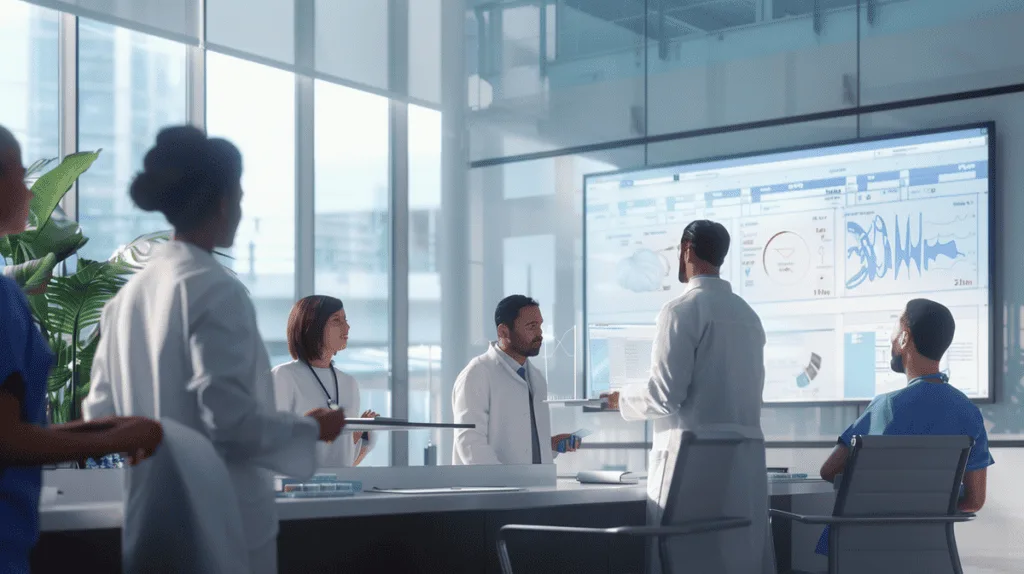Healthcare professionals are constantly looking for opportunities to increase patient safety and optimize processes. FMEA in healthcare is an excellent methodology to accomplish these objectives.
I’ve personally witnessed the systematic methodology of FMEA to proactively identify possible failures, and you’ll learn why it’s so essential for healthcare institutions and how it indirectly impacts patients.
Analyzing Medical Risk Assessment Techniques

FMEA in healthcare is designed to predict and prevent errors. It evaluates processes to determine where they might fail and then helps teams find solutions. The end result is improved patient safety and quality of care.
The history of FMEA in healthcare is fascinating:
- It was developed in the 1940s for the military.
- It was used by NASA in the 1960s.
- It became popular in healthcare in the 1990s and is now widely adopted in hospitals.
FMEA has several specific steps. Teams outline where a process might fail, estimate the severity of each failure, discuss how likely it is to occur, and then evaluate how easy it will be to detect the failure.
The benefits of FMEA in healthcare might surprise you. It reduces errors. It also improves patient outcomes. It saves you money because you’re preventing a mistake from occurring. FMEA also boosts staff morale. They feel like they can be proactive in finding and solving problems.
FMEA isn’t just a tactic. It’s an entirely different way of approaching healthcare quality. You’re not reacting to issues. You’re predicting and preventing them. This mindset shift will significantly improve patient care.
Types of FMEA in Healthcare
Healthcare has tailored FMEA to its specific needs. There are two primary variations you’ll encounter:
- traditional FMEA
- Healthcare Failure Mode and Effects Analysis (HFMEA).
Traditional FMEA originated in the manufacturing industry, so it primarily deals with product and process design. HFMEA, on the other hand, is designed specifically for healthcare. It addresses the nuances of medical processes.
The core differences between FMEA and HFMEA are substantial.
- HFMEA uses a simpler scoring system.
- HFMEA integrates decision trees for hazard analysis.
- HFMEA also places a greater emphasis on teamwork and interdisciplinary work.
So when should you use each one?
- Traditional FMEA is ideal for anything related to equipment.
- It’s perfect for analyzing medical devices or processes in the laboratory.
- HFMEA is designed for more complex clinical problems.
- Use it when analyzing patient care processes or conducting a system-wide process analysis.
HFMEA offers several advantages when applied in healthcare.
- It feels more natural to use for healthcare professionals.
- The simplified scoring model is easier to apply.
- And HFMEA accounts for the specific hazards that exist in healthcare.
- This includes variables like patient variation and human-based errors.
I’ve seen HFMEA have a positive impact on hospitals.
It forces teams to think more critically about their processes.
As a result, they identify errors that they would have missed before.
This ultimately allows them to make more targeted improvements and provide safer patient care.
Process for Implementing Failure Analysis in Medical Settings
Performing an FMEA in healthcare is a step-by-step process. To help you get started, here’s how to do an FMEA.
- Step #1: Assemble a Multidisciplinary Team of Nurses, Doctors, Administrators, and Other Relevant Staff
- Step #2: Define the Process
- Step #3: Identify Potential Failure Modes
- Step #4: Determine Severity, Occurrence, and Detectability Ratings
- Step #5: Calculate the RPN
- Step #6: Develop and Implement Corrective Actions
Here are some examples of potential failure modes:
- Wrong medication given to patient
- Incorrect dosage administered
- Medication given at wrong time
- Patient allergic reaction not recognized
- IV pump malfunction
I’ve conducted many FMEA analyses. It’s a process that opens your eyes to risks you weren’t aware of. More importantly, you can create solutions that directly impact patient safety.
FMEA Application in Healthcare Processes

- Medication administration: The entire medication process is under the microscope of a medication administration FMEA, from the prescription being written to the medication being administered. This type of FMEA has been instrumental in significantly reducing medication errors.
- Surgical procedure: A surgical procedure FMEA analyzes risks within the operating room, including pre-op, the surgery, and post-op. This FMEA has helped improve surgical outcomes and minimize complications.
- Laboratory testing: A laboratory testing FMEA analyzes the process of testing. This includes everything from how the sample is collected to how the result is reported. This FMEA has improved the accuracy and reliability of lab results.
- Patient handoff: A patient handoff FMEA evaluates the transfer of information from one care team to another. This is critical for care continuity. This FMEA has improved communication and minimized handoff errors.
- Emergency department triage: An emergency department triage FMEA scrutinizes how patients are sorted in the emergency department to ensure that urgent cases are prioritized appropriately. This FMEA has increased emergency department efficiency and patient outcomes.
Let’s analyze a specific case study. A teaching hospital in Sri Lanka conducted an FMEA on their medication process:
They identified 20 potential failure modes.
The team created 15 corrective actions.
Implementing these actions cut medication errors in half.
Staff reported that they’re more conscientious about patient safety.
This is a great example of an FMEA applied in a healthcare setting. It’s not just a concept. It’s a tool that works and drives results.
Challenges in Implementing FMEA in Healthcare
Using FMEA in healthcare is not without its challenges, and I’ve certainly faced many of them throughout my career. Let’s talk through some of the typical challenges to using FMEA in healthcare.
Resource limitations are often one of the biggest challenges healthcare organizations face. FMEA requires both time and resources from staff members, and in most healthcare environments, finding this time and these resources is tough. Staff members are likely already overworked and will push back on completing this additional analysis.
It can be challenging to accurately estimate the risk probability. Healthcare processes are often quite complex with numerous variables, and human interaction with the process adds an entirely new layer of complexity. As a result, assessing the risk probability can feel like a bit of a guessing game.
-
Another common challenge is maintaining momentum. Often, people are excited to complete the analysis at first, but then the excitement dwindles. Additionally, executing the action plan from the analysis can lag, and you need strong leadership to ensure the FMEA process is completed.
-
Balancing FMEA with other quality initiatives is also a common challenge. Most healthcare organizations already have a laundry list of quality initiatives they’re working on, so adding in FMEA can feel like a bit much.
Despite these challenges, I still find FMEA to be one of the most valuable tools in healthcare. The key is being aware of these challenges. Think through how to navigate them. With the right approach, you can overcome these challenges and will see the value of completing FMEA.
Tools and Software for FMEA in Healthcare
FMEA software helps automate the analysis process and makes documentation and tracking much easier. Here are a few options:
When selecting FMEA software, look for:
- easy-to-use interfaces
- tools with customizable templates
- good reporting which is a must
- bonus points if it integrates with other hospital systems
Here’s a comparison of some of the top FMEA software for healthcare:
| Software | Key Features | Pros | Cons |
|---|---|---|---|
| iGrafx | Process mapping, RPN calculation | Easy to use, comprehensive | Expensive |
| PHA-Pro | Risk matrix, action tracking | Powerful analytics, customizable | Steep learning curve |
| APIS IQ-Software | FMEA and FMECA support | Extensive libraries, great visuals | Complex for beginners |
Digital tools have many advantages for FMEA. They ensure:
- consistency in your documentation
- easier tracking of actions and progress
- many tools have data analysis capabilities to identify trends and prioritize risks
I’ve used all of these FMEA software in my career. While they’re helpful, remember they’re just tools. The real value is in the insights and actions of your team. The software is only helpful, not a replacement for a strong team and critical thinking.
A Few Last Words
I’ve been using FMEA in healthcare facilities for many years, and it’s an excellent tool to improve patient safety and the quality of care they receive. So, you now know the purpose, history, components, and advantages of FMEA. You also know the various FMEA methodologies and how to perform an FMEA.
You also know the different healthcare processes you can apply FMEA to. Keep in mind the potential roadblocks you may encounter when using FMEA. Select the appropriate tools to simplify the process. FMEA will make a big impact on your healthcare organization. Now, it’s your job to take action on this knowledge.


